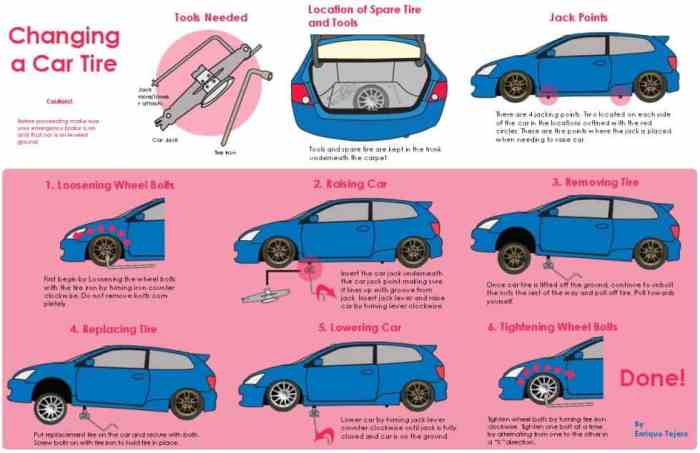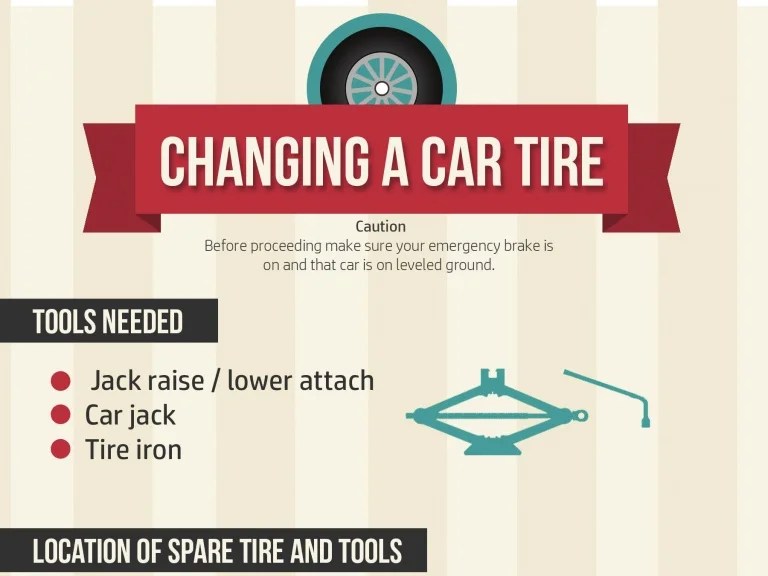How to change a tire infographic – In the realm of automotive maintenance, the ability to change a flat tire is a crucial skill. This infographic guide provides a step-by-step visual representation of the process, empowering readers with the knowledge and confidence to tackle this essential task.
Whether you’re an experienced driver or a novice behind the wheel, this infographic will guide you through each stage of the tire-changing process, from safety considerations to the final tightening of the lug nuts.
Safety Considerations: How To Change A Tire Infographic
Ensuring safety is paramount when changing a tire. Parking the vehicle on a flat, stable surface is crucial to prevent it from rolling or slipping during the process.
Engage the parking brake firmly to secure the vehicle. Additionally, put the transmission in park for automatic vehicles or in gear for manual vehicles.
Wearing Gloves and Safety Glasses
Wearing gloves protects your hands from dirt, grease, and potential sharp objects. Safety glasses shield your eyes from flying debris or chemicals that may be released during tire removal.
Gathering Necessary Tools and Materials
Adequately preparing for a tire change is essential to ensure a safe and efficient process. Gathering the necessary tools and materials is the first step towards a successful tire change.
Essential Tools
The following tools are crucial for a tire change:
- Lug wrench:A specialized tool designed to loosen and tighten lug nuts.
- Jack:A device that lifts the vehicle to provide access to the flat tire.
- Spare tire:A fully inflated and roadworthy tire to replace the flat one.
- Wheel chocks:Blocks placed behind the wheels opposite the flat tire to prevent the vehicle from rolling.
Choosing the Right Jack
Selecting the correct jack is essential to ensure stability and safety during the tire change. The jack should be:
- Rated for the weight of the vehicle.
- Capable of lifting the vehicle to a sufficient height to provide adequate clearance for tire removal.
- Sturdy and stable to prevent any accidents.
Spare Tire Inflation
The spare tire should be properly inflated to the recommended pressure indicated in the vehicle’s owner’s manual. An underinflated spare tire can compromise safety and handling, while an overinflated tire can lead to premature wear or even a blowout.
Positioning the Jack

Ensuring proper jack placement is essential for safe and effective tire changing. Vehicles have designated jack points specifically engineered to withstand the weight of the vehicle when lifted.
Locate these jack points in your vehicle’s owner’s manual or on the vehicle itself, typically indicated by notches or reinforced areas along the frame or pinch welds. Choose the jack point closest to the flat tire.
Stable Base for the Jack
The jack must rest on a stable and level surface to prevent it from sinking or slipping during the lifting process. Avoid placing the jack on soft ground, gravel, or uneven surfaces. If necessary, use a sturdy piece of wood or a purpose-built jack pad to distribute the weight and provide a stable base.
Lifting the Vehicle
After positioning the jack, the next step is to lift the vehicle safely and securely.
Begin by slowly pumping the jack handle to raise the vehicle. As you pump, carefully monitor the vehicle’s stability and ensure that it is lifting evenly. If the vehicle appears unstable or begins to tilt, stop pumping immediately and adjust the jack’s position as necessary.
Using a Jack Stand
For added safety, it is recommended to use a jack stand to support the lifted vehicle. Once the vehicle has been raised to a sufficient height, carefully place the jack stand next to the jack and adjust it to the appropriate height.
Slowly lower the vehicle onto the jack stand and remove the jack.
By following these steps and using proper safety precautions, you can safely lift your vehicle and proceed with the tire change.
Removing the Flat Tire
Once the vehicle is safely positioned and lifted, it’s time to remove the flat tire. This process involves carefully loosening and removing the lug nuts that secure the tire to the wheelbase.
Using the Lug Wrench, How to change a tire infographic
Locate the lug wrench, typically found in the vehicle’s trunk or under the seat. Use the wrench to loosen the lug nuts by turning them counterclockwise. Apply firm pressure and ensure the wrench is securely fitted onto the lug nuts.
Removing Lug Nuts by Hand
Once the lug nuts are loosened, remove them completely by hand. Grip the lug nut with your fingers and carefully unscrew it. Avoid using excessive force or dropping the lug nuts.
Removing the Flat Tire
With the lug nuts removed, carefully lift the flat tire straight up and away from the wheelbase. Avoid pulling or jerking the tire, as this can damage the wheelbase or tire.
Mounting the Spare Tire

Mounting the spare tire is a crucial step in the process of changing a flat tire. It requires precision and care to ensure the spare tire is securely fastened and the vehicle is safe to drive.
Aligning the Spare Tire
Before lifting the spare tire, ensure it is properly aligned with the wheelbase. The spare tire should be positioned so that the lug holes on the tire match up with the lug bolts on the wheelbase. Misalignment can cause difficulties when tightening the lug nuts and potentially lead to uneven tire wear.
Lifting and Placing the Spare Tire
Carefully lift the spare tire and place it onto the wheelbase. Use proper lifting techniques to avoid injury. Once the tire is in place, gently push it down to ensure it is fully seated against the wheelbase.
Tightening the Lug Nuts
Once the spare tire is in place, tighten the lug nuts by hand as much as possible. This will help prevent the lug nuts from becoming cross-threaded when using the lug wrench. After hand-tightening, use the lug wrench to further tighten the lug nuts in a star pattern.
Ensure the lug nuts are tightened securely but avoid overtightening, as this can damage the lug nuts or bolts.
Tightening the Lug Nuts

Once the spare tire is mounted, the lug nuts must be tightened securely to ensure the tire remains in place during driving. Using the lug wrench, carefully tighten each lug nut in a star pattern, alternating between opposite nuts. This pattern helps distribute the force evenly and prevents the wheel from becoming loose.
Applying Appropriate Torque
It is crucial to apply the correct torque when tightening the lug nuts. Overtightening can damage the lug nuts or wheel studs, while undertightening can lead to the wheel becoming loose. Refer to the vehicle’s owner’s manual for the specified torque value.
Use a torque wrench to ensure accurate tightening.
Lowering the Vehicle
Once the spare tire is mounted and the lug nuts are tightened, it is crucial to carefully lower the vehicle to ensure stability and safety.
To lower the vehicle, slowly release the pressure on the jack. Do this gradually to prevent any sudden movements or jolts. Once the vehicle is close to the ground, remove the jack stand (if used) by carefully sliding it out from under the vehicle.
Double-Checking Lug Nut Tightness
After lowering the vehicle, it is essential to double-check the tightness of the lug nuts. Use a torque wrench to ensure they are tightened to the manufacturer’s specifications. This step is crucial for ensuring the safe operation of the vehicle and preventing wheel detachment.
Stowing the Flat Tire and Tools
After changing the tire, properly stowing the flat tire and tools is crucial for safety and organization. Ensure the flat tire is placed securely in the designated storage area within the vehicle, often located in the trunk or under the cargo bed.
Organize and secure the tools and materials used during the tire change. Keep them in a designated storage compartment or bag to prevent them from rattling or becoming loose while driving. This ensures their availability for future use.
Importance of Inflating the Spare Tire
Maintaining the spare tire at its recommended inflation pressure is essential. An underinflated spare tire can compromise vehicle stability and handling, especially during emergencies. Regularly check the spare tire’s pressure using a tire pressure gauge and adjust it as needed.
Question Bank
What are the most common causes of flat tires?
Punctures from nails or screws, sidewall damage from hitting curbs or potholes, and gradual air leaks due to valve stem issues are among the most prevalent causes of flat tires.
How often should I check my tire pressure?
Tire pressure should be checked monthly, especially before long trips or when the weather changes significantly. Maintaining proper tire pressure extends tire life, improves fuel efficiency, and enhances overall vehicle safety.
Is it safe to drive on a flat tire?
Driving on a flat tire is extremely dangerous and should be avoided. Attempting to drive on a flat tire can damage the tire beyond repair and cause severe damage to the vehicle’s suspension and other components.